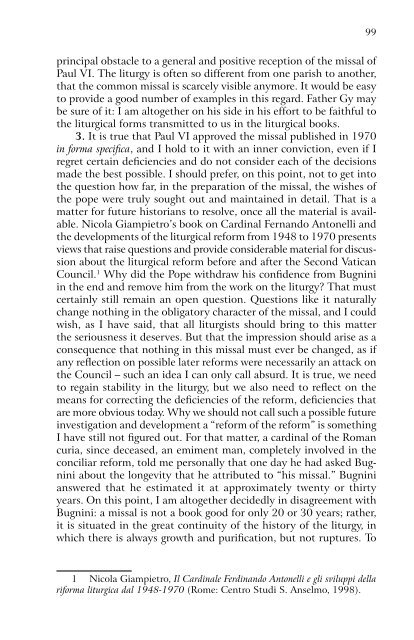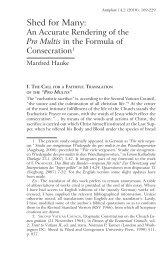Cardinal Ratzinger's The Spirit of the Liturgy: Is It ... - Liturgysociety.org
Cardinal Ratzinger's The Spirit of the Liturgy: Is It ... - Liturgysociety.org
Cardinal Ratzinger's The Spirit of the Liturgy: Is It ... - Liturgysociety.org
You also want an ePaper? Increase the reach of your titles
YUMPU automatically turns print PDFs into web optimized ePapers that Google loves.
principal obstacle to a general and positive reception <strong>of</strong> <strong>the</strong> missal <strong>of</strong><br />
Paul VI. <strong>The</strong> liturgy is <strong>of</strong>ten so different from one parish to ano<strong>the</strong>r,<br />
that <strong>the</strong> common missal is scarcely visible anymore. <strong>It</strong> would be easy<br />
to provide a good number <strong>of</strong> examples in this regard. Fa<strong>the</strong>r Gy may<br />
be sure <strong>of</strong> it: I am altoge<strong>the</strong>r on his side in his effort to be faithful to<br />
<strong>the</strong> liturgical forms transmitted to us in <strong>the</strong> liturgical books.<br />
3. <strong>It</strong> is true that Paul VI approved <strong>the</strong> missal published in 970<br />
in forma specifica, and I hold to it with an inner conviction, even if I<br />
regret certain deficiencies and do not consider each <strong>of</strong> <strong>the</strong> decisions<br />
made <strong>the</strong> best possible. I should prefer, on this point, not to get into<br />
<strong>the</strong> question how far, in <strong>the</strong> preparation <strong>of</strong> <strong>the</strong> missal, <strong>the</strong> wishes <strong>of</strong><br />
<strong>the</strong> pope were truly sought out and maintained in detail. That is a<br />
matter for future historians to resolve, once all <strong>the</strong> material is available.<br />
Nicola Giampietro’s book on <strong>Cardinal</strong> Fernando Antonelli and<br />
<strong>the</strong> developments <strong>of</strong> <strong>the</strong> liturgical reform from 948 to 970 presents<br />
views that raise questions and provide considerable material for discussion<br />
about <strong>the</strong> liturgical reform before and after <strong>the</strong> Second Vatican<br />
Council. Why did <strong>the</strong> Pope withdraw his confidence from Bugnini<br />
in <strong>the</strong> end and remove him from <strong>the</strong> work on <strong>the</strong> liturgy? That must<br />
certainly still remain an open question. Questions like it naturally<br />
change nothing in <strong>the</strong> obligatory character <strong>of</strong> <strong>the</strong> missal, and I could<br />
wish, as I have said, that all liturgists should bring to this matter<br />
<strong>the</strong> seriousness it deserves. But that <strong>the</strong> impression should arise as a<br />
consequence that nothing in this missal must ever be changed, as if<br />
any reflection on possible later reforms were necessarily an attack on<br />
<strong>the</strong> Council – such an idea I can only call absurd. <strong>It</strong> is true, we need<br />
to regain stability in <strong>the</strong> liturgy, but we also need to reflect on <strong>the</strong><br />
means for correcting <strong>the</strong> deficiencies <strong>of</strong> <strong>the</strong> reform, deficiencies that<br />
are more obvious today. Why we should not call such a possible future<br />
investigation and development a “reform <strong>of</strong> <strong>the</strong> reform” is something<br />
I have still not figured out. For that matter, a cardinal <strong>of</strong> <strong>the</strong> Roman<br />
curia, since deceased, an emiment man, completely involved in <strong>the</strong><br />
conciliar reform, told me personally that one day he had asked Bugnini<br />
about <strong>the</strong> longevity that he attributed to “his missal.” Bugnini<br />
answered that he estimated it at approximately twenty or thirty<br />
years. On this point, I am altoge<strong>the</strong>r decidedly in disagreement with<br />
Bugnini: a missal is not a book good for only 20 or 0 years; ra<strong>the</strong>r,<br />
it is situated in <strong>the</strong> great continuity <strong>of</strong> <strong>the</strong> history <strong>of</strong> <strong>the</strong> liturgy, in<br />
which <strong>the</strong>re is always growth and purification, but not ruptures. To<br />
Nicola Giampietro, Il <strong>Cardinal</strong>e ferdinando Antonelli e gli sviluppi della<br />
riforma liturgica dal 1948-1970 (Rome: Centro Studi S. Anselmo, 998).<br />
99



